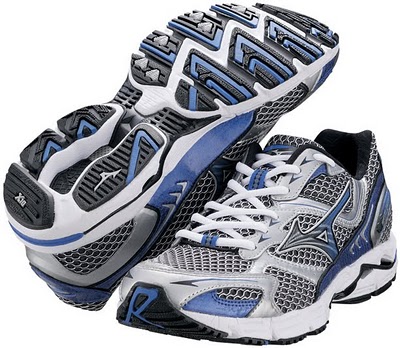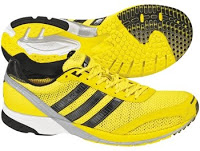It’s sometimes easy to forget that we are all at different in our thoughts about running shoes. Some of us prefer lots of cushioning, whereas other, like myself, prefer a more minimalist style. It’s also easy to forget that those of us who have gone minimalist often started off in more typical cushioned trainers. It is for this reason that I was intrigued when my dailymile friend Greg Strosaker indicated that he was interested in writing a guest post detailing his thoughts on his own running shoe journey. He’s very early on in his exploration of what I like to call “less shoe,” and I suspect it won’t be long before he winds up with a sleek, low-riding pair of racing flats – not that he needs the help as he can already kick my butt in a marathon!
I’ll let Greg tell his story in his own words, but I’ll add that if you want to read more about his running adventures, you can check out his blog, Predawn Runner.
Through maybe eight years total of cumulative running experience, and now seven marathons, I have actually never put much thought into my shoe selections. I’ve been lucky to be either blessed with mechanics that don’t care about shoe characteristics or to stumble upon shoes that worked with my gait and foot strike. Oh sure, I’d tried the wet-footprint approach to determine whether I needed neutral, control, or stability shoes and frankly found that I could make the answer whatever I wanted it to be. However, as I seek to up the intensity of my workouts in striving for a 3:00 Boston Marathon next year, I thought the time was right to finally let the experts weigh in. And, as with any new experience, I learned some things in the process.
First some history – I’d relied strictly on Asics Gel-1060’s (and its successors) and a couple of Nike models to get me to this point. I started my running with Asics – I mean who hasn’t heard about the Gel technology, and the 1060’s seemed like the “entry point” for the line. I didn’t think about the fact they are designed for stability, and whether I needed such stability or not. They worked fine, but were a little heavy. So, when I planned my first marathon (and the next several after that), I wanted a lighter shoe to provide a little boost, even if only mentally. I think they offered less stability than the Asics but with decent cushioning – but who knows. They worked, and I reached my first BQ in 2002 at Chicago using them.
When I returned to running last year after a 5 year hiatus, I owned the Nike+ system for the iPod so I naturally looked for a Nike shoe (and yes, I know you can get the Nike+ pod to work with other shoes, but who wants to go to that trouble). The first I tried were the Air Max Moto 6, and they felt fine, so I went with them. I wasn’t planning to get back to marathons at that time, but this ended up being a pretty good choice when I did – I gained my second BQ this spring in Cleveland using these sorta-neutral cushioned shoes. I did do a lot of damage to my pinky toenails though, so I had some concerns. And at 11.5 ozs., this is a pretty heavy shoe when every minute will matter. I also reverted to form and picked up some Asics GEL-1150’s as my second pair, and frankly found them uninspiring and thus limited to runs of 10 miles or less.
So that’s where I decided it was time to bring in the big guns. To do that, I went to Vertical Runner, a renowned running store in Hudson, Ohio (a suburb of Akron or Cleveland, depending on who you believe) whose employees always make a strong showing at local races. I wisely brought my Nike’s with me so they could see the wear patterns. I was lucky enough (I hope?) to work with Vince Rucci, the owner. His immediate impression on looking at my wear patterns and the way I stood was “this is too much shoe for you – you are extremely neutral.” Ignoring the fact that “extremely neutral” is a bit of an oxymoron, I was excited to learn this, because I heard “you can wear lighter shoes!” When he learned that I also wore the Asics Gel-1150’s, I feared he might slap me. “Way too much shoe” he said, “you don’t need that type of control because you most definitely don’t overpronate – I can also tell by your bowleggedness.”
I immediately began to think, “yes, Brooks Launch it is!” but he did restrain me a bit by steering me towards a few options that at least offered some cushioning. We started with the new Brooks Ghost 3. I liked them, but they were a bit heavy (weighing in at 11 ozs.) and a bit snug. We then tried the Mizuno Wave Rider 13. Definitely lighter, and I could particularly notice the reduced height of the heel. I had a similar impression with the Asics DS-Trainers. However, things still felt a bit snug, and when I mentioned my concerns about my toenails, Vince asked “was it your pinky?” Upon my “yes” answer, he responded, “well, then you need a wide shoe. “ If the shoes were too short, you’d have issues in your big toe. I had never considered this before. Wow, what a V8 moment (and you’d think my podiatrist would have pointed that out to me)!
So he brought out the Mizunos and Asics in 2E’s, and I gave them both another try. Now let me state my minor beef with Asics shoes – they don’t make the shoelaces long enough to double-knot, so I was constantly retying my Gel-1150’s. And yes, I know I could put in new laces, but see paragraph 3. When they both felt similar on a trial run, I went with the Mizunos. And, I’ll be honest, I liked the way they looked.
So, here are the impressions after around 30 miles on the Mizunos – what a contrast to my previous shoes. You can absolutely feel the road in these – in fact, I feel like I’m gripping the road as I run. Like many things in life however, this strength may be also be their greatest weakness – I’m concerned how they will feel at the marathon distance. So I’m going to build up the distance slowly, using them for only stepback long runs, speedwork, and easy runs initially (still mixing in with the Nike’s).
I also noticed some changes in how my muscles felt during training – there was more soreness on the first run in my inner shins and hamstrings, which I presume is due to getting used to a slight change in my gait (but may have been from the tail end of a tough running week). The shin issues have disappeared, but the hamstrings still fell a little tighter than normal. The lower heel compared to the Nike’s seems to be forcing (allowing?) me to be less of a heel striker (and honestly I was already surprised as to how little wear the Nike’s had on the heel (see below), compared to the two pairs I owned last year) and I’m sure that’s forcing some adjustments in my motion.
So time will tell. It is difficult to run “controlled experiments” in running as there are too many variables we can’t control (fatigue and weather, most notably). If the soreness continues, I will go back and try the Brooks Ghost 3’s (which I may do anyway). But now I know (a) I need wide shoes, and (b) I don’t need much stability and it is in fact counter-productive, so I will be making wiser shoe choices from this point forward. And I still foresee a performance trainer in my future, at least for shorter races.




















Interesting reading, Greg (and Pete). It is amazing the difference that a knowledgeable store proprietor can make in decisions like this — kudos to your guy for taking the time to understand what you needed/wanted, and to being more committed to getting you what you needed instead of just racking up a profit.
Thanks Paula – yes, for once I didn’t feel like the goal was a profit (not to say that the Mizuno Wave Riders are cheap), though I really didn’t even know the price until checkout, so in a way we were both focused on getting the right solution. At least, I hope!